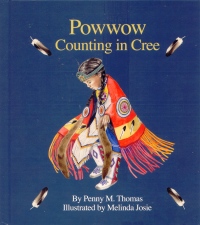| ________________
CM . . . . Volume XXI Number 3 . . . . September 19, 2014
excerpt:
A concept book, Powwow Counting in Cree provides the Cree words for the numbers from one to 10 and imbeds them in the event of a powwow. Each number is treated via a pair of facing pages with the left-hand page carrying (with one three-line exception) a four-line poem with the Cree "number" word being printed in blue. The full-colour illustrations, which carry the "objects" to be counted, occupy the other page, though occasionally they spill over onto the text page. The book concludes with a "How to say the [Cree] words..." page.
The connection between time and footwear seems a stretch. As noted at the beginning of the review, the numbers are imbedded within the happening of a powwow, and the dancers and drummers found in the illustrations obviously fall within a powwow's scope, but what role do the newo [four] eagles or the tepakohp [seven] "teachings sent from heaven" play? When I reflected on the contents of Powwow Counting in Cree, I felt the book could have been so much more than what it was. In addition to the two questions above concerning eagles and teachings, I had other unanswered questions about the book's contents, including: What exactly is a powwow? What was that "shepherd's crook"? Was there any significance to the clothing worn by the nisto "three pretty ladies"? For some reason, I decided to take a look at the publisher's website, www.portageandmainpress.com, and what did I find there but a Teacher's Guide for Powwow Counting in Cree. Published a year after Powwow Counting in Cree, this resource for teachers answered all of my questions, including the one I had about the "shepherd's crook", explaining, in part, "An eagle staff is featured in the book. Eagle staffs are sacred items that are created to honour a person or community of people." The guide begins with a chart that connects the book's 10 illustrations with the various activities that are set out in the guide. The next three sections provide discussion topics, information and activities for early years students that relate to the Cree language, powwows and the Cree culture. The final two sections focus their activities and information on eagles and the seven sacred teachings. All of the suggested activities are connected to specific subject areas: language arts, mathematics, science and social studies. As well, there are many references to websites that will provide further information or provide live action examples. Overall, the Teacher's Guide for Powwow Counting in Cree is an excellent resource for teachers. Parents, however, will not likely want to spend any additional money for this "extra" book. Consequently, should Powwow Counting in Cree go into a reprint, the publisher might consider replacing the "How to say the words..." page with an information page that would provide non-teacher adults with some of the basic facts needed to make the contents of Powwow Counting in Cree more enriching for their children. Highly Recommended. Dave Jenkinson, CM's editor, lives in Winnipeg, MB. Copyright © the Manitoba Library Association. Reproduction for personal use is permitted only if this copyright notice is maintained. Any other reproduction is prohibited without permission.
Next Review |
Table of Contents for This Issue
- September 19, 2014. |

 While Powwow Counting in Cree is a book that should be in all libraries, especially those serving Cree children, it is not without its faults. Firstly, the pronunciation guide should not be a separate page that requires the [likely adult] reader to have to repeatedly turn back and forth in order to be able to learn how to pronounce the Cree words; instead, the instructions on how to pronounce a number in Cree should be found somewhere on the two pages devoted to that specific number. Though the Cree words for one to 10 are the focal point of the book, it is also a "counting" book. For the most part, what is to be counted is obvious, but the objects for niyanan are five "pairs" of moccasins. I can see readers at the younger end of the book's audience range arriving at a count of 10. And speaking of 10, its object is what appears to be a single feathered "shepherd's crook". Again, will younger readers recognize that the feathers are what are to be counted? With one exception, the text and illustrations are highly congruent, the one exception being "five". Recall that was the page with the five pairs of moccasins, but the text reads:
While Powwow Counting in Cree is a book that should be in all libraries, especially those serving Cree children, it is not without its faults. Firstly, the pronunciation guide should not be a separate page that requires the [likely adult] reader to have to repeatedly turn back and forth in order to be able to learn how to pronounce the Cree words; instead, the instructions on how to pronounce a number in Cree should be found somewhere on the two pages devoted to that specific number. Though the Cree words for one to 10 are the focal point of the book, it is also a "counting" book. For the most part, what is to be counted is obvious, but the objects for niyanan are five "pairs" of moccasins. I can see readers at the younger end of the book's audience range arriving at a count of 10. And speaking of 10, its object is what appears to be a single feathered "shepherd's crook". Again, will younger readers recognize that the feathers are what are to be counted? With one exception, the text and illustrations are highly congruent, the one exception being "five". Recall that was the page with the five pairs of moccasins, but the text reads: